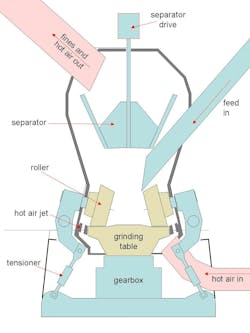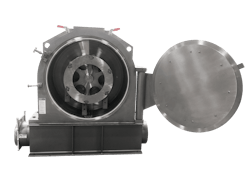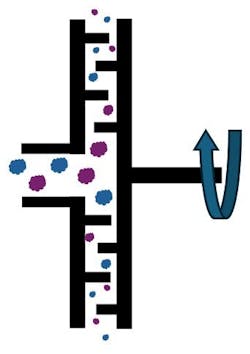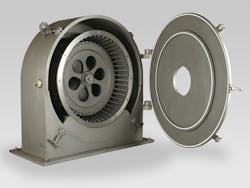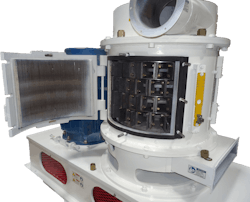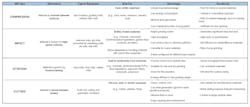Basics of industrial grinders

The Greek philosopher Plato is credited with saying, “Necessity is the mother of invention.” The invention of grinding techniques dates to ancient times when early civilizations relied on it for survival and development. One of the earliest examples of a grinder is the hammerstone, a tool fashioned from hard stone such as basalt, quartzite or granite and used to impact and chisel flint into tools for tasks such as cutting, scraping and hunting. Grinding techniques later evolved into more complex tasks, such as cutting grains into flour with stones, crushing ores for metal extraction, pulverizing herbs for medicine and smashing minerals and plants in the manufacture of pigments and dyes.
Ancient tools such as mortars and pestles, grinding stones and basic mills laid the foundation for more sophisticated grinders in later centuries. Today, industrial grinders can be found across multiple industries, blending ancient principles with modern technology. Industrial grinders used for particle size reduction leverage four different mechanical forces to break down solid materials into smaller particles — compression, impact, attrition, and cutting — and grinders can be classified according to which mechanical force they use. This article will devote a section to each grinder type, providing an overview of the technology, its common uses and other considerations for implementation and maintenance.
Compression grinders
Compression type grinders apply a lateral force to crush material between two surfaces. A few examples include jaw crushers, gyratory mills and roller mills. They are often used as primary and secondary grinders for mined rock and ore, for grinding cement, and in the power generation industry as a primary crusher for large-scale processing of coal into fine powder. Another type of roller mill is adapted to crush food and grain, such as coffee and wheat.
Compression type grinders are designed to be robust to withstand the rigors of their application. They operate at lower speeds and with higher torque, making them well suited for processing harder, heavier, more abrasive materials. They can often achieve high capacities, making them energy efficient as a primary size reduction step. Due to their design, compression type grinders are used for coarse size reduction with minimal creation of fine particles.
Common compression type grinders include:
Jaw crushers. Jaw crushers compress particles between a fixed jaw plate and an angled, movable jaw plate (Figure 1). Material is fed into the top of the machine and repeatedly crushed by reciprocal motion of the movable plate. As the jaw plates separate, the crushed material moves down into a narrower section for further crushing into progressively smaller pieces. Material discharges through a gap at the bottom of the converging jaw plates.
Gyratory mills. Gyratory mills utilize a shaft with cone-shaped head, or mantle, reciprocating inside a stationary concave bowl. The head’s gyratory motion opens and closes a gap against the bowl, compressing and crushing the material passing through. As with a jaw crusher, the gap between head and the bowl converges at the bottom, crushing the particles further as the material falls to the discharge. Unlike the reciprocal motion of a jaw crusher, the gyratory motion allows for continuous crushing.
Vertical roller mills. Vertical roller mills are designed with a rotating table with three vertical rollers positioned over it (Figure 2). Material fed onto the center of the table is centrifugally propelled outward and into the path of the rollers, which compress and crush the material against the table surface. Vertical roller mills can also utilize an updraft of hot air to dry the material and lift away the finely ground particles. Some mills are also equipped with a classifier head at the top that separates the fine particles, redirecting coarser ones back to the table for more crushing.
Impact grinders
Impact type grinders strike and shatter particles with the force of a rotating object, such as a hammer or blade. Common types are hammermills, pin mills, universal mills/air classifying mills, jet mills and ball mills. They are commonly used for medium, fine and ultra-fine grinding in a wide variety of industries, including mining, construction, chemicals, food processing and pharmaceuticals.
Unlike compression grinders, impact mills typically operate at higher speeds and lower torque. They are ideally suited to achieve efficient size reduction of friable (brittle) materials, with certain types also adapted to products containing higher fat or moisture. Impact mills are also highly configurable to control particle size, allowing the user to produce coarse or fine powders.
Due to their high speed and low torque, the mass and hardness of material fed into an impact mill require special consideration. Materials with a high mass can damage the impact mill’s rotor or grinding elements. In this case, a pre-crushing step with another type of machine may improve the mill’s efficiency. Similarly, harder, more abrasive materials may require wear-resistant parts.
Common impact type grinders include:
Hammermills. Hammermills, also known as hammer-and-screen mills, utilize a rotor containing hammer blades or anvils attached to a pivot point (Figure 3). As the rotor spins, the hammers/anvils impact the particles, accelerating them toward a stationary screen. The screen provides a basic classification of particle size, where larger particles shatter against the screen surface, then recoil into the path of the hammers/anvils. On-size particles pass through the screen and exit the mill. Hammermills are suitable for coarse and medium grinding by manipulating the number of hammers and the size of the screen openings. They are highly suitable for pulverizing grain, processing food ingredients, reducing wood or biomass and for waste management/recycling applications, such as the processing of electronic waste, paper, cardboard and municipal waste.
Pin mills. Pin mills are designed with one stationary and one rotating disc, each containing pins that intermesh when the rotating disc spins (Figure 4). Material fed through an opening in the stationary disc enters the gap between the disc faces, where airflow and centrifugal force propel the material outward. The accelerated particles collide with the pins on both discs. Pin mills are suitable to manufacture uniform, medium particle sizes through manipulation of the grinder speed, the quantity/pitch of the pins and the material flow rate. Because they do not utilize screens, they are better suited than impact mills for processing materials with more challenging flow properties, such as certain oil seeds and press cake.
Universal grinding mills. Universal grinding mills work like hammermills, except that the impact blades are fixed to the wheel and fastened such that impact is achieved on the blade face, not a thin edge (Figure 5). Material impacted by the blades is accelerated outward towards a series of cutting plates and/or screens, depending on the model. On-size particles exit the grinding process through a gap between the cutting plates or through the screen holes, if so equipped. Universal grinding mills are capable of medium to fine grinding by controlling the grinder wheel speed, gap setting and screen size, when applicable.
Air classifying mills. Air classifying mills are a variation of the universal grinding mill, where particles are first ground, then classified by an independently controlled wheel that recirculates the coarsest particles back into the grinding zone using centrifugal force. Universal grinding mills and air classifying mills operate in a pneumatic system and can achieve fine and ultra-fine particle sizes by manipulation of rotor speed, screen size and classifier rpm (if equipped). The air is essential to conveying the material, controlling dust and limiting temperature rise.
Jet mills. Jet mills are well suited for ultra-fine grinding to micron and sub-micron particle sizes using a high-velocity compressed gas (usually air, nitrogen or steam) to create particle-on-particle collisions. As high-pressure gas is injected tangentially into a grinding chamber through nozzles, a spiraling jet stream accelerates the particles to near sonic velocities. The particles impact against one another rather than the grinding surface, greatly reducing wear to the machine surfaces. The mill also contains few to no moving parts, which simplifies maintenance.
Ball mills. Ball mills are well suited for fine and ultra-fine grinding of materials into fine powders. Some common applications are ores, clinker, slag, ceramics, chemicals, paint/coatings and food ingredients. Ball mills utilize a horizontal cylindrical shell containing steel or ceramic balls (media). As the cylinder rotates, the media is lifted and then cascades down, smashing the material. Ball mills can be operated in batch or continuous mode and can work in an open or closed circuit with classifiers for finer outputs.
Ball mill cylinders and media can be made to be abrasion resistant, making them suitable for tougher materials, but they can also be energy intensive and therefore not efficient for coarser products. Batch mode can also be time consuming, factoring in the time to load and unload the mill.
Attrition grinders
Attrition type grinders operate by abrading particles against one another and against a cutting surface. Two examples are disc mills and rotormills. Attrition grinders are suitable for medium to fine grinding of dry to slightly moist materials, and they excel at processing soft, fibrous and temperature-sensitive materials. They can also be outfitted with wear-resistant parts to increase service life when handling abrasive materials. Attrition mills are well suited for temperature-sensitive materials or for applications that require a uniform particle size.
Like pin mills, attrition mills do not use a sizing screen; particle size is easily controlled using the gap between the rotating and stationary surfaces, the rotor speed, the solids flow rate and the airflow.
Common applications for attrition type mills include ceramics, pharmaceuticals/APIs, a wide variety of food ingredients (such as cocoa, spices and nut pastes), chemicals and pigments, composites and polymers. Attrition mills are less adaptable for processing hard materials, where high impact force may be better suited.
Common attrition type grinders include:
Disc mills. Disc mills work very similarly to pin mills, except the opposing faces of the discs contain teeth or a profiled surface to aid in cutting and shearing the particles. As the rotor spins, material is caught against the profiled surfaces, shearing particles into smaller pieces. Centrifugal force moves the material outward through the periphery of the discs. Some mills have adjustable spacing between the discs. This gap setting, along with the rotor speed, allows for precise particle size control.
Rotormills. Rotormills are constructed with a tall, vertical rotor fitted within a body lined with a corrugated surface (Figure 6). Starting below the grinding chamber, airflow is used to draft material upward through a gap between the rotor and lining, where the rotor imparts centrifugal force to the particles and turbulence to the air. This action creates a high shear as particles impact one another and the lining. Particle size is controlled via the rotor speed, gap setting, air velocity and solids flow rate.
Rotormills can also be used with a heated air source to provide both drying and grinding in a single step.
Cutting mills
Cutting type mills perform mechanical size reduction using sharp blades or knives to cut, shear or slice materials into smaller pieces. Unlike the other types of mills discussed so far, they primarily rely on cutting forces, making them ideal for fibrous, soft, elastic or tough materials. Common types are knife mills and shredders.
Cutting type mills are used for processing the following types of products: plastics and polymers, such as rubber, PVC, PET and thermoplastics; foods, such as vegetables, meat, nuts and frozen products; pharmaceuticals, including herbs, roots and tablets; textiles, such as cloth, fibers and non-wovens; wood and pulp, including chips, bark and cellulose; and recycling, including foam, paper, waste packaging materials and some synthetics.
Cutting type mills have the advantage of producing uniform particle sizes, such as flakes and diced pieces, without creating fine dust. They also generate little heat, making them suitable for handling soft materials. Cutting mills can also handle oddly shaped, stringy or elastic products that are challenging to feed into other types of mills.
Cutting mills are NOT good for processing hard materials. They also tend to process material more slowly than other types of mills and are more susceptible to wear of the cutting or shearing elements, therefore a good inspection plan is recommended to maintain peak performance.
Common cutting type mills include:
Knife mills/granulators. Knife mills/granulators utilize a rotor with sharp knives that rotate against a cutting plate or screen surface (Figure 7). They are best for general purpose cutting and shearing to create uniform particles. Material enters the top of the machine, where a series of knives grab and shear the material along the mill’s stationary surfaces. Particle size is easily controlled via the mill speed, knife gap setting and screen size.
Shredders. Shredders utilize counter-rotating parallel shafts with intermeshing, close-tolerance blades with a hooked tooth profile. As the teeth rotate inward toward one another, they grip, pull and shear the material into smaller pieces. The reduced material is discharged from the bottom of the unit. Shredders can handle high volumes of large bulky, heterogeneous material and offer superior torque to handle large jobs. Their low speed and robust construction make them long lasting with low maintenance needs.
A diverse range of capabilities
The four classes of industrial grinding machines described in this article have a diverse range of capabilities, allowing manufacturers to tailor their grinding processes to their specific industry and application. These capabilities also enable manufacturers to achieve value added benefits, such as improved material handling and storage; increased surface area for greater reactivity, dissolution or heat transfer; and a variety of enhancements to downstream processing, such as mixing, drying, pelletizing or extraction.
About the Author

Darrell Malczewski
Midwest regional sales manager for Prater Industries
Darrell Malczewski ([email protected]) is the Midwest regional sales manager for Prater Industries, a global supplier of airlocks, size reduction and screening/separation equipment. His 25 years of bulk material handling experience include various roles with Prater, including test lab manager, technical field services, airlock product manager and currently regional sales.

